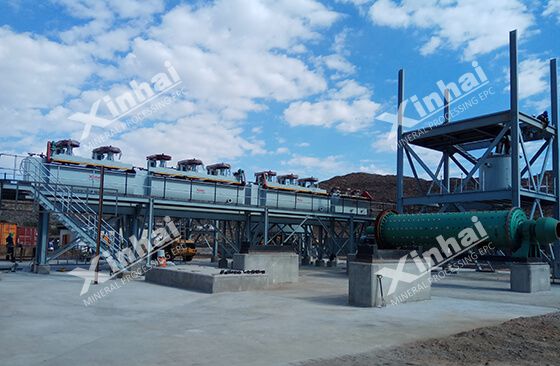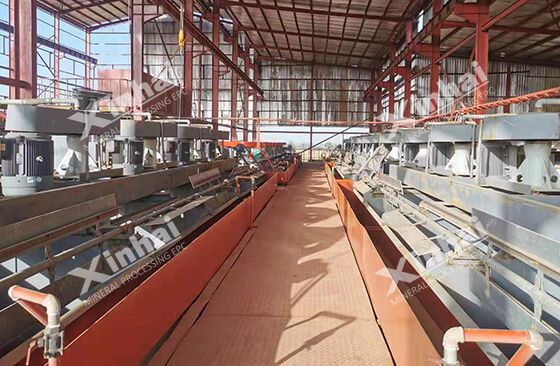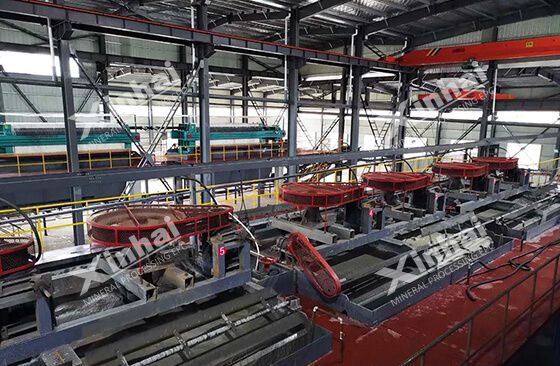
The flotation process of single copper sulfide ore is relatively simple. The main principle is to carry out flotation and throw tailings under rough grinding conditions as much as possible, thus reducing costs, increasing economic benefits, and achieving good beneficiation indicators.

There are mainly the following three flotation processes in common use:
Grinding fineness is an important factor affecting the beneficiation index of copper sulfide ore.If the grinding particle size is too fine, the ore is easy to be over-crushed, which affects the separation process and increases the grinding cost.If the grinding particle size is too coarse, the copper minerals will not be effectively dissociated, which will affect the recovery rate and the improvement of the concentrate grade.
After the first stage of grinding, the copper sulfide ore in the one-stage grinding-flotation process would reach a fineness of 50-60% -200 mesh and would be basically dissociated. Then the copper ore enters the flotation stage, and better flotation indicators can be obtained through one roughing, one scavenging and one to three times concentrating.
This flotation process is suitable for the copper minerals with coarse and uniform grain size, loose combination with gangue, and smooth and flat contact edges.The process is with simple flow and low beneficiation cost, so it is used more in small and medium-sized copper concentrators.

The rough concentrate obtained from copper sulfide flotation contains a large amount of conjoined fine porphyry-quartz. In order to obtain a higher grade copper concentrate and increase the recovery rate of the final copper concentrate, it is necessary to regrind the rough concentrate and strengthen the monomer dissociation.
The grinding fineness of the raw ore in this process is 40%-70% -200 mesh after the first stage of grinding. In the flotation process, a large amount of tailings are thrown away through roughing and scavenging. The rough concentrate obtained from the flotation would be reground, and afterwards, the final copper concentrate could be obtained after two to three times of concentrating.
This process is suitable for processing copper-molybdenum ore or single sulfide ore of porphyry copper.This process can reach better mineral processing indexes and economic benefits when the raw ore grade is low and the processing volume is large.Due to the regrind of the rough concentrate, the particle size is fine, the monomer dissociation of copper minerals, gangue minerals and pyrite is good, so the quality of the flotation concentrate is higher.

In order to reach monomer dissociation of most of the copper minerals, it is necessary to grind the ore finer. In this case, two-stage grinding will be used, and the grinding fineness has to reach about 80% of -200 mesh, or finer.After the ore is coarsely ground in the first stage, a part of the coarse-grained copper minerals can be transported to the flotation stage. This part of the copper concentrate is of higher grade and can be used directly as a concentrate or enter the final beneficiation, or combine with the concentrates which after two stage grinding and flotation to be final concentrate.
This flotation process is suitable for copper sulfide ore with uneven thickness. It adopts two stage grinding-two stage (one stage) flotation process for separation, adheres to the principle of getting the concentrate as soon as possible, and can maximize the recovery rate of the target mineral.Two-stage grinding is better than one-stage grinding in terms of grinding efficiency and preventing over-crushing of copper minerals. Therefore, this process is often used by large and medium-sized copper ore concentrators.

The above are three common single copper sulfide flotation processes. Different copper sulfide ores have different particle sizes and different mineral structures. We should choose the appropriate separation process according to the nature of the ore itself, and remember not to apply any process indiscriminately.
In order to obtain better flotation indicators and economic benefits, we recommend you to conduct a beneficiation test before determining the beneficiation process
To find out more about our products and solutions, please fill out the form below and one of our experts will get back to you shortly.